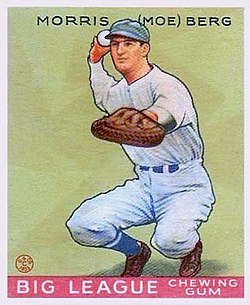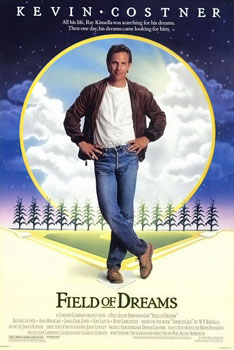
Field of Dreams is a 1989 American sports fantasy drama film written and directed by Phil Alden Robinson, based on Canadian novelist W. P. Kinsella's 1982 novel Shoeless Joe. The film stars Kevin Costner as a farmer who builds a baseball field in his cornfield that attracts the ghosts of baseball legends, including Shoeless Joe Jackson and the Chicago Black Sox. Amy Madigan, James Earl Jones and Burt Lancaster also star.

Morris Berg was an American professional baseball catcher and coach in Major League Baseball who later served as a spy for the Office of Strategic Services during World War II. He played 15 seasons in the major leagues, almost entirely for four American League teams, though he was never more than an average player and was better known for being "the brainiest guy in baseball." Casey Stengel once described Berg as "the strangest man ever to play baseball."
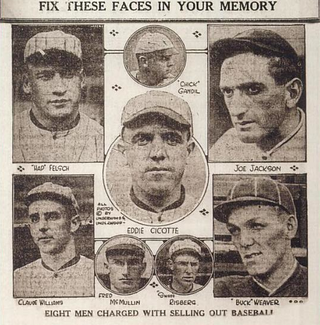
The Black Sox Scandal was a Major League Baseball game-fixing scandal in which eight members of the Chicago White Sox were accused of losing the 1919 World Series against the Cincinnati Reds on purpose in exchange for money from a gambling syndicate led by organized crime figure Arnold Rothstein. In response, the National Baseball Commission was dissolved and Judge Kenesaw Mountain Landis was appointed to be the first Commissioner of Baseball, given absolute control over the sport to restore its integrity.

George Robert "Birdie" Tebbetts was an American professional baseball player, manager, scout and front office executive. He played in Major League Baseball (MLB) as a catcher for the Detroit Tigers, Boston Red Sox and the Cleveland Indians from 1936 to 1952. Tebbetts was regarded as the best catcher in the American League in the late 1940s.
Paul Rosbaud, was a metallurgist and scientific adviser for Springer Verlag in Germany before and during World War II. He continued in science publishing after the war with Pergamon Press in Oxford, England. In 1986 Arnold Kramish revealed the undercover work of Rosbaud for the British during the war in the book The Griffin. The Greatest Untold Espionage Story of World War II. It was Rosbaud who dispelled anxiety over a "German atom bomb".
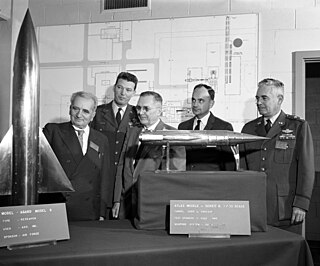
The Advisory Group for Aerospace Research and Development (AGARD) was an agency of NATO that existed from 1952 to 1996.

Charles Richard Lau was an American professional baseball player and a highly influential hitting coach. During his playing career in Major League Baseball, Lau appeared in 527 games as a catcher and pinch hitter over all or portions of 11 seasons for four clubs. Then, beginning in 1969, he spent 15 years as a coach for five American League teams, most notably the Kansas City Royals. He was the incumbent hitting coach of the Chicago White Sox when he died, aged 50, from colorectal cancer in 1984.

Gian Carlo Wick was an Italian theoretical physicist who made important contributions to quantum field theory. The Wick rotation, Wick contraction, Wick's theorem, and the Wick product are named after him.

Joe Hicks Tipton was an American professional baseball player. He played as a catcher in Major League Baseball (MLB) from 1948 through 1954 with the Cleveland Indians, Chicago White Sox, Philadelphia Athletics, and the Washington Senators. In 417 career games, Tipton recorded a batting average of .236 and accumulated 29 home runs, and 125 runs batted in (RBI).

Major League II is a 1994 American sports comedy film and sequel to the 1989 film Major League and it is the second installment in the Major League film series. The film stars most of the same cast from the original, including Charlie Sheen, Tom Berenger, and Corbin Bernsen. Absent from this film is Wesley Snipes, who played Willie Mays Hayes in the first film and who had become a film star in his own right by 1994. Omar Epps took over his role. Several new cast members appear in Major League II. David Keith plays Jack Parkman, a selfish superstar catcher who is looking to replace the aging Jake Taylor as the starter. Takaaki Ishibashi, of Japanese comedic duo Tunnels, is outfielder Isuro "Kamikaze" Tanaka who helps excite the team. Eric Bruskotter is rookie catcher Rube Baker who is getting used to the MLB life. Unlike the first film, which was rated R, Major League II was rated PG and released by Warner Bros. instead of Paramount Pictures.
Nicholas Dawidoff is an American writer.
The following are the baseball events of the year 1942 throughout the world.
The following are the baseball events of the year 1934 throughout the world.
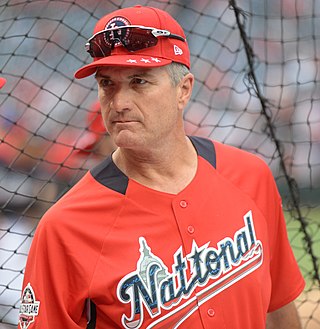
Robert Peter Geren is an American former professional baseball catcher and manager, who played in Major League Baseball (MLB) for the New York Yankees (1988–1991) and San Diego Padres (1993). Geren managed the Oakland Athletics from 2007 through 2011. He served in various coaching capacities for the A's and New York Mets, and Los Angeles Dodgers. He is currently the major league field coordinator for the Dodgers.

Mose Hirsch Solomon, nicknamed the Rabbi of Swat was an American left-handed baseball player. In 1923, he hit 49 home runs in the minors, a new minor league record. He briefly played for the New York Giants in Major League Baseball in 1923.
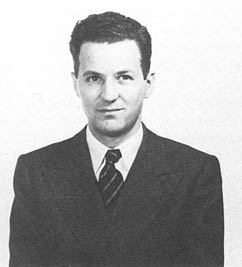
Antonio Ferri was an Italian scientist, prominent in the field of aerodynamics, with a specialization in hypersonic and supersonic flight.

Antonio Francisco Peña Padilla is a Dominican former professional baseball player, manager and coach. He played as a catcher in Major League Baseball for the Pittsburgh Pirates, St. Louis Cardinals, Boston Red Sox, Cleveland Indians, Chicago White Sox, and Houston Astros. After his playing career, Peña was the manager of the Kansas City Royals between 2002 and 2005. He was most recently the first base coach for the New York Yankees. A four-time Gold Glove Award winner, Peña was known for his defensive abilities as well as his unorthodox squat behind home plate.

"This Won't Kill You" is a Nero Wolfe mystery novella by Rex Stout, first published as "This Will Kill You" in the September 1952 issue of The American Magazine. It first appeared in book form in the short-story collection Three Men Out, published by the Viking Press in 1954.

The Catcher Was a Spy is a 2018 American war film directed by Ben Lewin and written by Robert Rodat, based on the book of the same name by Nicholas Dawidoff. It stars Paul Rudd as Moe Berg, a former baseball player who joined the war effort during World War II and participated in espionage for the U.S. Government. Mark Strong, Sienna Miller, Jeff Daniels, Tom Wilkinson, Giancarlo Giannini, Hiroyuki Sanada, Guy Pearce, and Paul Giamatti also star. The film premiered at the 2018 Sundance Film Festival, and was released on June 22, 2018, by IFC Films.
Harold Herman Bender was an American philologist who taught for more than forty years at Princeton University, where he served as chair of the Department of Oriental Languages and Literature. He was the chief etymologist for Webster's New International Dictionary, Second Edition.

